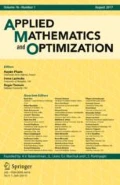Abstract
This paper is devoted to the study of the following inverse problem: Given the 1-D wave equation:
how to determine the parameter functions (ρ(z),μ(z)) from the only boundary measurementY(t) ofy(z, t)/z=0.
This inverse problem is motivated by the reflection seismic exploration techniques, and is known to be very unstable.
We first recall in §1 how to constructequivalence classes σ(x) of couples (ρ(z),ρ(z)) that areundistinguishable from the givenboundary measurements Y(t).
Then we give in §2 existence theorems of the solutiony of the state equations (1), and study the mappingσ→Y: We define on the set of equivalence classes Σ={σ(x)|σ min ⩽σ(x) ⩽ σ max for a.e.x} (σ min andσ max a priori given) a distanced which is weak enough to make Σ compact, but strong enough to ensure the (lipschitz) continuity of the mappingσ→Y. This ensures the existence of a solution to the inverse problem set as an optimization problem on Σ. The fact that this distanced is much weaker than the usualL 2 norm explains the tendency to unstability reported by many authors.
In §3, the case of piecewise constant parameter is carefully studied in view of the numerical applications, and a theorem of stability of the inverse problem is given.
In §4, numerical results on simulated but realistic datas (300 unknown values forσ) are given for the interpretation of seismic profiles with the above method.
Similar content being viewed by others
References
A. Bamberger, G. Chavent, and P. Lailly, Une application de la théorie du contrôle à un problème inverse de sismique,Annales de Géophysique, 33, 183 (1977).
A. Bamberger, G. Chavent, and P. Lailly, Etude mathématique et numérique d'un problème inverse pour l'équation des ondes à une dimansion,Rapport LABORIA n° 226, IRIA, BP 105, 78150 Le Chesnay, Rapport Centre de Mathématiques Appliquées n° 14, Ecole Polytechnique, 91128 Palaiseau Cedex.
G. Chavent, Deux résultats sur le problème inverse dans les équations aux dérivees partielles du deuxième ordre en t et sur l'unicité de la solution du problème inverse de la diffusion, C.R. Acad. SC, Paris 270, 25–28 janvier 1970.
D. M. Detchmendy, Attenuation and inverse problems in wave propagation,Esso Production Research Company (Swieeco 1968), Houston, Texas.
M. L. Gerver, The inverse problems for the vibrating string equation, Irv. Acad. Sci. URSS,Physic Solid Earth (1970–71).
B. Gjevick, A. Nilsen, and J. Hoyen, An attempt at the inversion of the reflection datas,Geophysical Prospecting, 24, 492–505 (1976).
B. Gopinath, and M. M. Sondhi, Inversion of the telegraph equation and the synthesis of non-uniform lines,Proc. IEEE, 59, 3 (1971).
G. Kunetz, Quelques exemples d'analyse d'enregistrement sismiques,Geophysical Prospecting, II, 4 (1963).
C. Lemarechal, Nondifferentiable optimization subgradient andε-subgradient methods,Lect. Notes in Econ. and Math. Systems, 117,Optimization and Operational Research, Springer, Berlin, 1976.
J. L. Lions,Contrôle optimal de systèmes gouvernés par des équations aux dérivées partielles, Dunod, 1968.
F. Murat, Contres exemples pour divers problèmes où le contrôle intervient dans les coefficients,Annali Mat. ed applicata 4, 112, 49–68 (1977).
S. Spagnolo, Convergence in energy for elliptic operators, inNumerical Solution of Partial Differential Equations, III (Synspade 1975), B. Hubbard, ed., Academic Press, New York, 1976.
Author information
Authors and Affiliations
Additional information
Communicated by J. L. Lions
Rights and permissions
About this article
Cite this article
Bamberger, A., Chavent, G. & Lailly, P. About the stability of the inverse problem in 1-D wave equations—application to the interpretation of seismic profiles. Appl Math Optim 5, 1–47 (1979). https://doi.org/10.1007/BF01442542
Accepted:
Issue Date:
DOI: https://doi.org/10.1007/BF01442542


